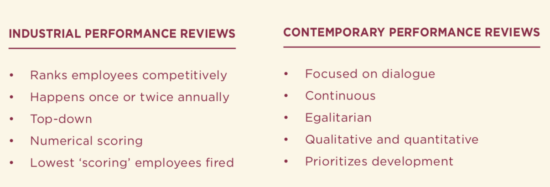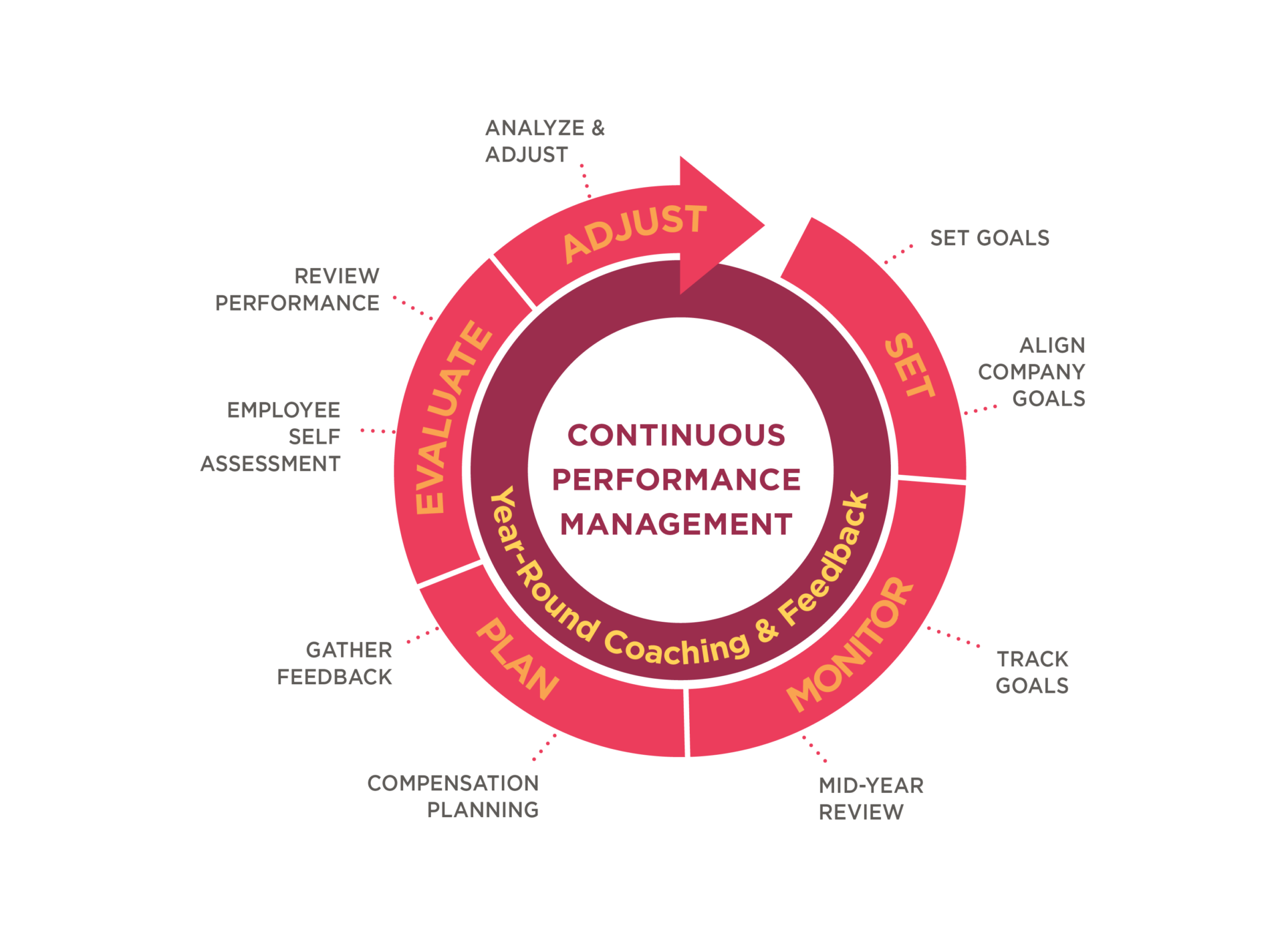HR professionals operate in a fast-growing industry, with those in established businesses competing with global startups who better understand the modern world of work, and respond agilely to the ebbs and flows of people management.
One legacy issue that many HR managers face is the traditional performance review. Between generational workplace shifts and an evolving understanding of organizational psychology and performance management, HR managers are tasked with implementing and overseeing new ways of performance management in which many cases are unrecognizable from decades-old systems.
The problem: Are current performance reviews as we know them dead?
There are two typical styles of performance review seen in the current workplace, representing the shifting priorities of HR professionals and the C-suite. The ‘old’ or ‘industrial’ model involves a ranking system where a formal review is conducted once or twice a year, with employees scored in a competitive fashion, and those scoring least being dismissed.
The modern approach is more in tune with changing employee demographics, who are looking for opportunities to improve their skills, asking for growth support, and seeking coaching in their career. This method of performance ‘review’ is a continuous approach that casts the manager in the role of coach.

According to Josh Bersin, a radical shift from the former to the latter has taken place: 10 years ago, 75% of companies took the industrial approach, and today the reverse is true. In a 2018 article, he goes on to describe the crucial reason underpinning this change, which is that the industrial style review system is based on the assumption that management creates value, and where employees’ labor is ‘more or less replaceable.’ However, Bersin’s position challenges this assumption:
“I’d suggest that we may have the whole thing reversed: the employees (line people) are more important than ”the managers in most companies…”
Josh Bersin, HR Thought Leader
As we’ve shifted away from the industrial era – in which employees, as assembly line workers, were almost part of the machinery – and into an era where professional services have become preeminent, each individual employee becomes important for their creative or intellectual value to the organization. So, HR has had to evolve away from the so-called ‘rank and yank’ model.
Performance management only emerged as a concept in the 1970s, and it’s only in the last two decades (according to Bersin) that its influences, such as what we see in the contemporary performance review, has gained widespread traction in organizations – but this rapid change in corporate management structure has left many organizations struggling to redirect their culture, management style, and systems to meet the demands of a “transformed workforce.
“…so we need to invert the whole thing and understand the ‘managers serve the employees’ and not the other way around.”
Josh Bersin, HR Thought Leader
The challenge: Today’s workforce expects frequent feedback
Personal growth is a huge priority for today’s employees. According to research conducted by Robert Walters, 91% of Millennials – soon to overtake Baby Boomers as the largest demographic cohort – consider career development as a number one priority in their jobs. The same Robert Walters study found that 60% of Millennials wanted formal feedback every 1 to 3 months, but a significant 38% reported receiving formal feedback once a year or even less.
Additionally, according to Gallup, only 2 in 10 employees say their performance is managed in a way that motivates them to do outstanding work, and only 14% found that their performance reviews inspired them to work. These dismal figures spell a challenge for HR teams which involves:
- Creating a culture that encourages growth and improvement
- Helping managers grow as coaches and take a skills development approach
- Finding new ways to track and report on data
The solution: The new world of performance reviews
The new type of performance review should be conceptualized as a give and take, occurring in an ecosystem of feedback that doesn’t just happen from the top down but in a continuous conversation between the employees, managers, colleagues, and customers.
Rather than one big meeting every year – which is by its nature distant from many of the events under review – bite-sized data is collected and relayed with regular check-ins, perhaps as an evaluation following a project or after the close of a quarter, with constant micro-adjustments along the way.
In this model, employees also get to feed in about how their career is developing and work in conjunction with managers to map out a path for growth, thus integrating the idea of performance management or high performance with regular review and feedback, optimizing career growth. In this way, both the manager and the employee have responsibilities for setting and reaching goals.

Your implementation checklist
Your checklist for implementing the new performance process
☐ Create the culture
Before you even think about performance management, you need to focus on engineering the culture so that it promotes open dialogue, feedback, and critique. See the next page for best-practice tips on how to build this kind of culture.
☐ Identify the kind of data that needs to be collected
Data is still a key driver of performance management under a more modern style of performance review. Consider productivity, participation, retention, engagement, and other more specific KPIs.
☐Implement new ways to gather and analyze this data
By dispensing with the traditional once-or twice-annual performance review, there’s no longer a sense of scoring or ranking; with a continuous dialogue around performance – much of which will be informal – teams may have to try new ways of capturing and reporting the data.
☐ Test different kinds of tools on the market for managing the performance review process
There are plenty of tools to assist in gathering and analyzing data in a way that streamlines the review process for managers and HR. Do some research to find out which one will suit your organization best.
☐ Train managers in new performance review and management techniques
Particularly if your organization has been running on the ‘industrial’ performance review style, you may need to train managers in new tools and improve understandings of what performance management is and its function within management.
☐ Create a system that gives multi-directional feedback
Ensure that ‘feedback’ doesn’t simply flow from the manager downwards, but from employees to leadership and between colleagues.
☐ Make participation a requirement
To ensure the quality of data and full involvement, create a culture where participation is an expectation.
☐ Incentivize enthusiastic engagement
Make getting involved in the culture a priority for team members by offering incentives for enthusiastic participation.
How to foster a culture and environment for ongoing, open dialogue
“The best way for companies to reduce turnover is through open and proactive communication.
Ask your employees how the company can better support them and be a place people enjoy working. Once you listen to the feedback, take action to improve the employee experience. Open dialogue on what needs to change, how you’ll change it, and the results after the change is key to driving turnover down.”Sarah O’Neill – SHRM-SCP
1. Ask (and answer) questions
Asking employees and managers questions – through surveys
and non-formal feedback routes – let employees feel as if they
have a say in building the culture. This is your first port of call
for fostering dialogue in an authentic way.
The aim is to create an environment that asks employees what they think and engages with the answers. Going a step further and creating dedicated channels for communication empowers employees to raise issues when they come up instead of having to wait to be asked.
2. Prioritize transparency
In a culture where every member of the organization is striving to improve, the spotlight also has to be turned onto management and leadership. In order to encourage a culture of positive development, organizations must demonstrate reflection, evaluation, critique, and improvement at all levels. This means taking steps like publishing the company’s objectives and results and being honest about misfires.
Taking on the startup world’s embrace of failure as a means to embracing growth and development may be key to creating a culture of open dialogue. “To invent you have to experiment, and if you know in advance that it’s going to work, it’s not an experiment. Most large organizations embrace the idea of invention, but are not willing to suffer the string of failed experiments necessary to get there,” Bezos wrote in an Amazon annual shareholder letter.
3. Encourage disagreement and dissent
While many shy away from dissenting voices, Harvard Business Review asserts that “dissent plays an important role in the workplace… In places where dissenting opinions are encouraged, employees report greater job satisfaction, and leaders are able to consider a wider range of proposals and options before making decisions.”
Recent reporting on Facebook’s company culture of Facebook has revealed that the company’s ‘no-dissent’ policy has encouraged a ‘cult-like’ experience, with the structure of company performance review and the peer review system leading to a toxic environment where sexual harassment and issues with the product went unreported: “[former employees] say Facebook might have caught some of these problems sooner if employees were encouraged to deliver honest feedback.”
4. Know and support growth goals
Part of performance management and creating a culture of open dialogue is the vision of the manager as the coach. With this understanding of the role, understanding the employee’s goals becomes key to helping them grow in their role and improve performance.
Supporting their goals by developing the skills and knowledge required goes hand in hand with performance management and also retention, so creating structures of mentorship, career development and upskilling can be one way to ensure that employees have greater satisfaction in their roles and motivation to succeed.
5. Recognize high performance
According to Josh Bersin, who has conducted an in-depth analysis on recognition at work, people are highly motivated by recognition – but it has to be the right kind of recognition.
His study found that:
-
53% of employees didn’t think their company had any
recognition program -
87% of all recognition programs are based purely on years
of service -
44% of recognition programs don’t include company goals
as part of the program
All this means that employees aren’t getting recognized by their workplaces in a way that drives positive outcomes. Meanwhile, companies in the top 15% of building a culture of recognition have a 46% lower rate of voluntary attrition. As Bersin explains:
“These are companies that regularly appreciate and thank their people, and this drives engagement, retention, and 12-15% improvements in overall employee performance… Modern and sound employee recognition programs appeal to these higher level needs [self- actualisation, the need for community], making people feel good, and in turn work harder, take better care of customers and each other), and make your business better.”
Recognition is, therefore, a key part of the performance management process, as it creates a positive feedback loop and the benefits flow on into areas like retention and productivity.
Conclusion
While this new approach to performance management could be construed as catering to Millennials’ reported ‘entitlement’ and need for constant praise (myths, by the way), research by Gallup and others have found that what’s good for Millennials is actually good for business. As this generation becomes the most influential in the workplace, the business will improve for the better as a result of their preferences.
This approach will ultimately save time and money for your business through increased engagement and decreased turnover. Instead of a disconnected, top-down approach,
HR teams who implement a data-backed and contemporary performance management system will see a higher level of engagement, better products, and ultimately greater retention.
Meet Bob
We know how important it is to make holistic, data-driven decisions
about your people, especially in light of today’s modern workplace
trends. That’s why we built Bob, a people management platform
that reinvents old performance processes with new perspectives
that focus on your people’s feedback, goals, and growth.
The main tools that Bob uses to address these topics can be found in our advanced Surveys, Goal Setting, and Performance Management features.
Bob puts purpose into performance
Surveys
Make data-driven decisions and better understand your people based on evidence, not assumptions.
- Anonymous feedback
- Company health and culture
- Personalized form editor
Recommended For Further Reading
Goal setting
Motivate productivity by putting meaning behind what your people do with vision and company alignment.
- Easy to track KPIs
- Spot top talent as individuals or teams
- Assign objectives
Performance management
Define and optimize your review cycles to create understanding, transparency, and mutual trust with your people.
- Customized questionnaires
- Simplified dashboards and timeline view
- Insights on employee strengths
In 2020, it’s time to make smarter decisions
when it comes to your people and organization.
